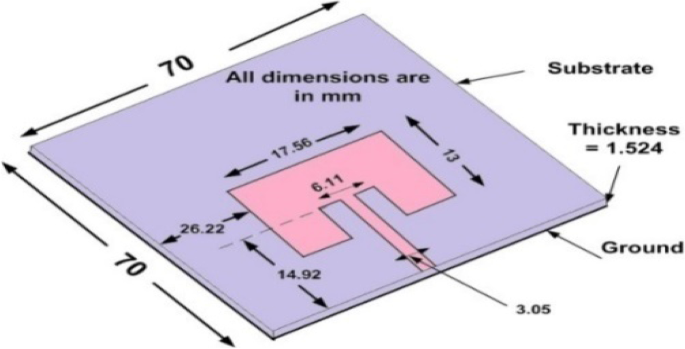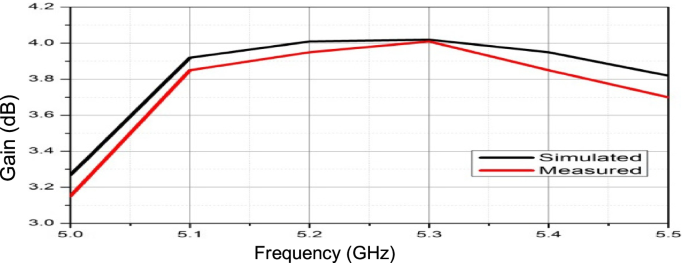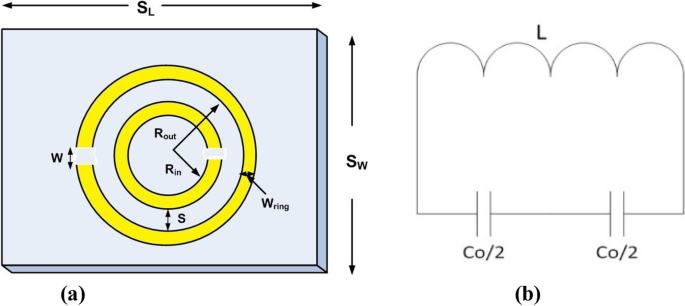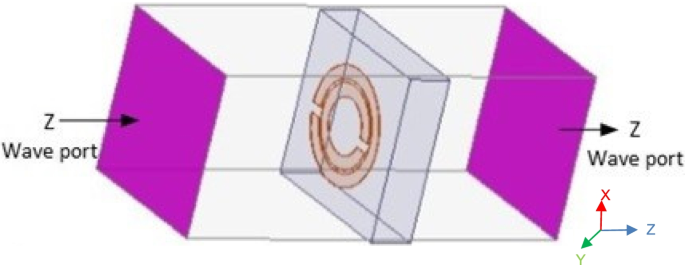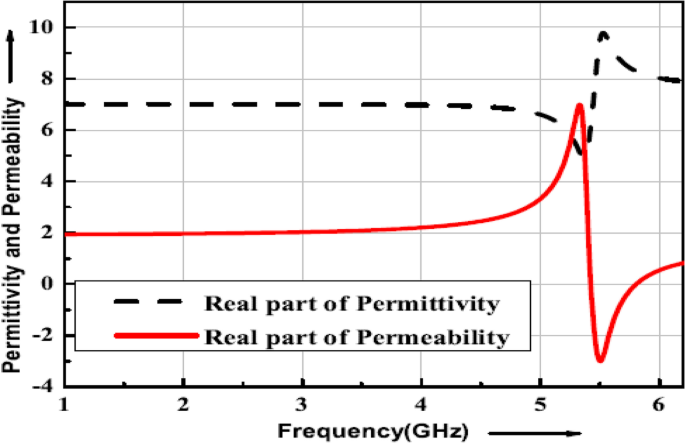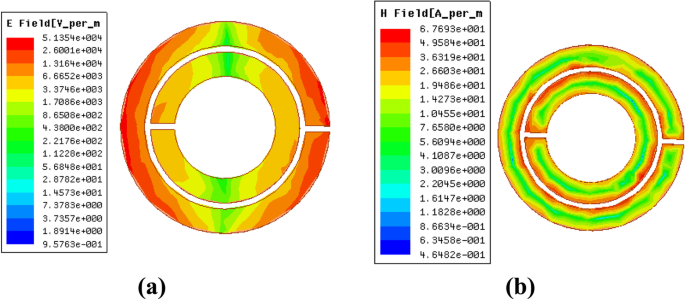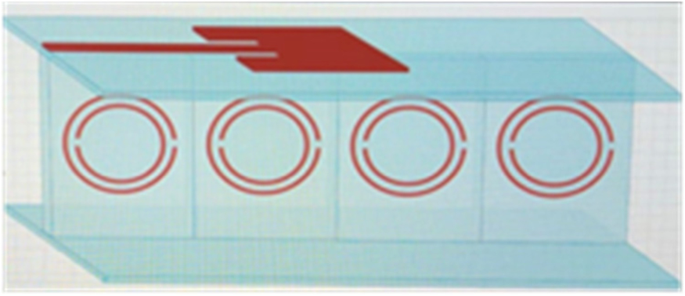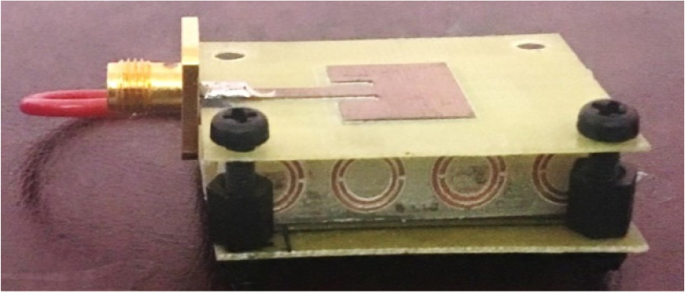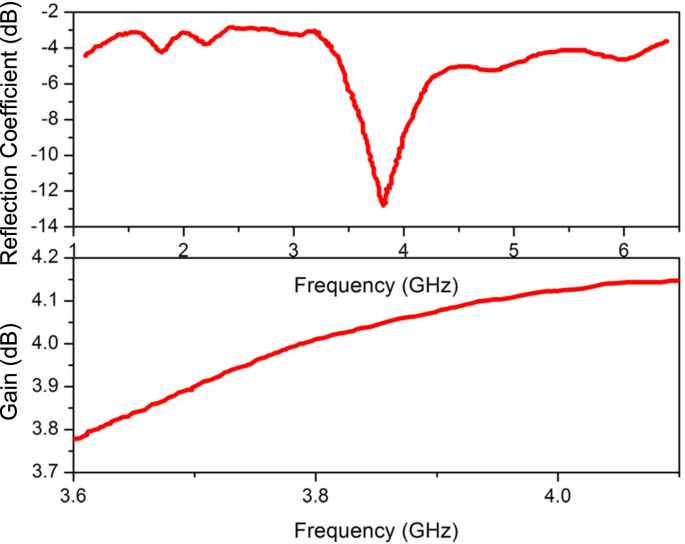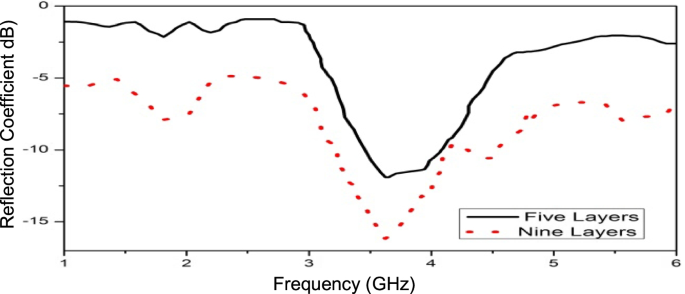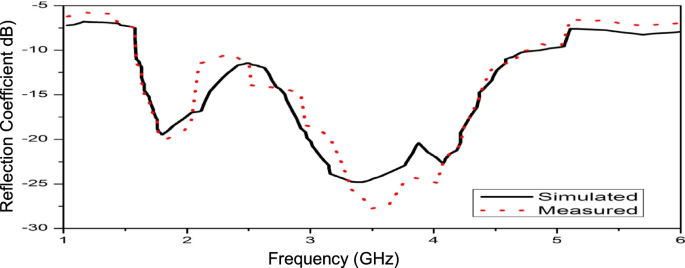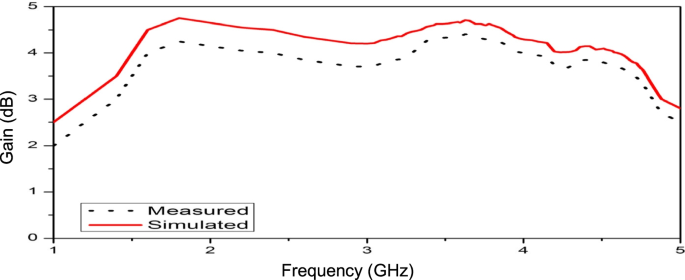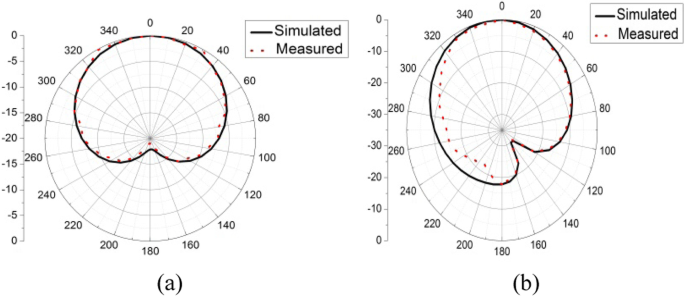- Research
- Open access
- Published:
SRR metamaterial-based broadband patch antenna for wireless communications
Journal of Engineering and Applied Science volume 69, Article number: 47 (2022)
Abstract
This paper presents the design and analysis of a broad-band patch antenna using split ring metamaterial. The SRR metamaterial structures are embedded in a unique and novel way in the patch antenna, so that subwavelength modes get introduced in the patch cavity and a broad bandwidth antenna with good performance characteristics is obtained. A rectangular microstrip patch antenna is taken as a reference antenna, which resonates at a frequency of 5.2 GHz and has an impedance bandwidth of 70 MHz. To improve the bandwidth of the patch antenna, firstly the split ring resonator (SRR) is designed according to the reference patch antenna. The optimized SRR metamaterial is placed in between the patch and ground plane of the proposed antenna. The – 10 dB impedance bandwidth of the metamaterial-embedded proposed antenna is 1.63–4.88 GHz and has an average gain of 4.5 dB. The Prototype of the proposed antenna and reference antenna is fabricated and experimental results are obtained. Experimental and simulated results are in good agreement. The presented antenna can be used for LTE, GSM, WiMAX, Bluetooth, and other wireless applications.
Introduction
In modern days, with the advancement in the wireless and electronics industry need for compact, broadband, high-gain, directional and low-cost antennas has increased very much because the antennas are the vital components in wireless communication system [1]. Patch antennas are low profile, have a simple geometric structure with the ability of easy fabrication on PCB and can be easily integrated with other wireless devices. So, these antennas are suitable for current wireless technology [2]. But one of the limitations of these antennas is narrow bandwidth. The bandwidth of patch antenna can be improved by embedding different shapes such as U shape and W shape in its ground plane [3], using a parasitic patch [4] and increase of substrate thickness. These techniques improve the bandwidth, but it reduces the efficiency of the antenna. Many other approaches like the slotted patch antenna technique, defected ground structures, merging of resonant modes [5], slotted array technique [6], and suspended techniques [7] are proposed in the literature. But these approaches have disadvantages of less improvement in bandwidth, complex structure, cross-polarization and impedance matching.
During the last few years, metamaterials have been the intense area of research in antenna design to improve antenna performance [8,9,10,11,12,13]. Metamaterials are artificial materials that exhibit properties that do not exist in naturally occurring materials. To improve the bandwidth of patch antenna different types of metamaterial [14,15,16,17,18] has been used by antenna designers for improving the bandwidth. A MIMO antenna with four ports is proposed by Xia Cao et al. [19] using a slotted square ring metamaterial structure to improve the bandwidth. Metamaterial-based imaging structure for wireless frequency range is presented in [20]. But the limitation of techniques used in these research works is that it improves the bandwidth, but it reduces the other performance parameters of the antenna and has complex antenna structures.
The main aim of this paper is to design a novel broadband patch antenna using metamaterial without degrading the other performance parameters of the antenna. The proposed technique in this paper uses 11 layers of SRR type MNG type metamaterial which are embedded between patch and ground plane. These SRR metamaterial structures are embedded in a unique and novel way in the patch antenna to improve the bandwidth of the reference patch antenna and make it broadband. The proposed patch antenna has wide bandwidth with good performance characteristics.
Methods
Design of reference antenna
A low-cost FR4 epoxy substrate with dielectric constant εr = 4.4 and loss tangent δ = 0.0025 is chosen for designing of reference antenna. The antenna is modeled and optimized in HFSS software. The optimized geometric parameters of the reference antenna are presented in Fig. 1 and fabricated antenna is presented in Fig. 2. From Fig. 3, it can be seen that the reference antenna resonates at a frequency of 5.2 GHz with a − 11.68 dB reflection coefficient (S11) and has a 70-MHz narrow impedance bandwidth. Figure 4 shows the measured and simulated gain in dB. The antenna has a gain of 4.02 dB at resonating frequency. The main drawback of this antenna is that it has a very narrow bandwidth and less return loss, which is not suitable for current wireless applications. So, SRR metamaterial is used in this paper to improve the bandwidth and overall performance of the antenna.
Design and analysis of unit cell of split ring resonator
A split ring resonator (SRR) comprises two concentric rings of copper printed on substrate material. Geometric parameters of SRR are presented in Fig. 5a. Excitation of SRR with external magnetic field causes the current to flow from one ring structure to other through the slot between them. So, there is flow of very strong displacement current in this structure. The slots in SRR behaves like distributed capacitance and it behaves like LC circuit. The equivalent circuit of unit cell of SRR is presented in Fig. 5b. In equivalent circuit, metallic ring structures are modeled by inductance L and capacitance C = Co/4 (Co/2 = capacitance due to single ring and structure behaves like LC circuit having resonant frequency given below as:
SRRs effective permeability can be given as
Unit cell of split ring resonator is modeled and simulated in HFSS as shown in Fig. 6. For simulation of SRR metamaterial unit cell boundary conditions are used. Repeated unit cell boundary conditions are applied along x and y direction (xy plane) and wave ports are applied in z direction as shown in Fig. 6. The S parameters of optimized SRR structure are calculated and then permeability and permittivity are extracted from S parameters using the Eqs. (3–6).
Real value of permeability (μr) and permittivity (ϵr) is shown in Fig. 7. From permeability and permittivity graph it can be analyzed that real part of permeability of SRR at 5.4 GHz is negative and real part of permittivity is positive and maximum at his frequency, so this is MNG type resonating metamaterial. Refractive index (\(n=\sqrt{\mu \varepsilon\ }\Big)\)is product of permittivity and permeability and is negative in this range. Figure 8a, b shows E-field and the H-field of SRR structure. It shows that when SRR is excited with external magnetic field, it causes the current to flow from one ring structure to other through the slot between them. Hence there is a flow of strong displacement current in SRR structure.
Design and fabrication of proposed SRR-embedded patch antenna
For designing a broad-band antenna, optimized unit cell of SRRs is placed in between the patch antenna and ground plane. For this, the reference antenna substrate thickness is divided in two parts of 0.8 mm. The exploded view of SRR-embedded antenna is presented in Fig. 9. Each layer of metamaterial placed under patch consist of four-unit cell of SRR.
The optimized SRR-embedded antenna consists of 11 layers of metamaterial to achieve maximum bandwidth.
The optimized and designed SRR-embedded antenna is fabricated using PCB prototyping machine. Figure 10 presents the fabricated SRR layer and Fig. 11 presents the fabricated proposed SRR-embedded patch antenna with 11 layers of metamaterial.
Results and discussion
Simulation and measured results of proposed SRR-embedded patch antenna
The proposed SRR antenna presented in Fig. 11 is simulated and optimized in HFSS. Reflection coefficient of fabricated antenna is measured using vector network analyzer (VNA). The gain and radiation patterns of antenna are measured in anechoic chamber. As the SRR is placed under patch, subwavelength modes get introduced in the patch antenna. Effect of adding the different layers of SRR underneath the patch is studied extensively in this paper. Addition of three layers under patch cause the patch to resonate at 3.8 GHz with impedance bandwidth of 80 MHz as presented in Fig. 12. The antenna has gain of 4.05 dB at this frequency as presented in Fig. 12. As the more layers of SRR is embedded under the patch it causes more modes to get introduced in patch antenna and resonant frequency also shift towards the lower side. Addition of five layers increases the bandwidth of patch antenna from 80 MHz to 150 MHz and addition of nine layers introduces one mode at frequency of 1.8 GHz and other two modes at 3.5 GHz and 4.5 GHz as presented in Fig. 13.
When 11 layers of SRR is added all the three modes introduced by nine layers of metamaterial get merged and broad-bandwidth of 3.25 GHz is obtained. Figure 14 shows the simulated and measured reflection coefficient graph of proposed antenna with 11 layers of metamaterial. From this graph, it can be seen that antenna resonates between 1.62 GHz and 4.87 GHz and it covers the wide bandwidth of 3.25 GHz. The return loss of this proposed patch antenna improves from − 11.68 dB to − 25.2 dB and has average gain of 4.5 dB in the resonating frequency range of 1.63 GHz to 4.88 GHz as shown in Fig. 15. Addition of more layers of metamaterial underneath the patch does not show further improvement in results. Hence, the proposed antenna has 11 layers of SRR under the patch. This antenna has good average gain of 4.5 dB in the entire resonating frequency range. Figure 16 presents the simulated and measured E-plane and H-plane radiation pattern of this antenna at 3.5 GHz. Proposed and reference antenna has almost same radiation pattern in both planes.
Table 1 provides the comparison of various performance parameters of the reference antenna and proposed antenna. The conventional reference patch antenna produces a limited impedance bandwidth of 70 MHz. The SRR metamaterial improves the bandwidth of patch antenna significantly from 70 MHz to 3.25 GHz. Thus, bandwidth is multiplied by 46.42, which is huge improvement in bandwidth. The return loss of antenna also improves after embedding metamaterial and proposed antenna also has good gain in resonating frequency range. Due to introduction of various subwavelength modes in metamaterial-embedded antenna resonant frequency of reference antenna get shifted to lower frequency range of 1.63 GHz to 4.88 GHz from 5.4 GHz. All these subwavelength modes get merge and give rise to broad-bandwidth. Table 2 shows the comparison of proposed work with the other similar works. As per comparison, this can be concluded the embedding of SRR layer using proposed method gives significant improvement in bandwidth and designing and fabrication of proposed antenna is also very simple.
Conclusions
Developments of electronic warfare system and wireless communication in modern fast developing technologies include the use of metamaterial in antenna system for improving the performance of overall system. A broadband metamaterial-embedded antenna is proposed in this paper to adjust with current wireless systems. The presented antenna covers the frequency band of 1.63 GHz to 4.88 GHz is designed, analyzed and measured in this research paper. Simulated results shows that the presented antenna has bandwidth of 3.25 GHz (1.63–4.88 GHz) and the experimental results are close to simulated one. The proposed antenna has significant bandwidth and has average gain of 4.5 dB. The other advantages of proposed antenna are that it is cheap, simple, can be easy fabricated with PCB machine and can be integrated with other wireless devices. The presented antenna can be used for LTE, GSM, WiMAX, Bluetooth, and other wireless applications.
Availability of data and materials
The datasets generated during and/or analyzed during the current study are available from the corresponding author on reasonable request.
Abbreviations
- ENG:
-
Epsilion NeGative
- GSM:
-
Global System for Mobile Communications
- HFSS:
-
High-frequency structure simulator
- LTE:
-
Long-term evolution
- PCB:
-
Printed circuit board
- SRR:
-
Split ring resonator
- WiMAX:
-
Worldwide Interoperability for Microwave Access
References
Bougoutaia T, Khedrouche D, Hocini A (2016) Bandwidth improvement for compact microstrip patch antenna using metamaterials. Acta Phys Pol A 129:538–540. https://doi.org/10.12693/APhysPolA.129.538
Kumar A, Saini G, Singh S (2016) Design and simulation of metamaterial loaded substrate integrated waveguide fed patch antenna for X-band military application, pp 550–554. https://doi.org/10.1109/WiSPNET.2016.7566195
Shanmuganantham T, Raghavan S (2009) Design of a compact broadband microstrip patch antenna with probe feeding for wireless applications. Int J Electron Commun 63:653–659
Hidayat T, Zulkifli FY, Basari, Rahardj ET (2013) Bandwidth and gain enhancement of proximity coupled microstrip antenna using side parasitic patch. ICRAMET, Surabaya, p 95
Chen T, Chen Y, Jian R (2019) A wideband differential-fed microstrip patch antenna based on radiation of three resonant modes. Int J Antennas Propag 2019:4656141. https://doi.org/10.1155/2019/4656141
Rivastava H, Singh A, Rajeev A et al (2020) Bandwidth and gain enhancement of rectangular microstrip patch antenna (RMPA) using slotted array technique. Wirel Pers Commun 114:699–709. https://doi.org/10.1007/s11277-020-07388-x
Rathod AK, Bhakar MM, Mathpati MS (2020) Bandwidth and gain improvement by using suspended techniques in hexagonal micro strip patch antenna for wireless applications. Int J Control Autom 13(4):689–694 http://sersc.org/journals/index.php/IJCA/article/view/18858
Abdalla M, Abdelnaby U, Mitkees AA (2012) Compact and triple band meta-material antenna for all WiMAX applications. In: IEEE international symposium on antenna and propagation, pp 1176–1179
Qamar Z, Naeem U, Khan SA, Chongcheawchamnan M, Shafique MF (2016) Mutual coupling reduction for high-performance densely packed patch antenna arrays on finite substrate. IEEE Trans Antennas Propag 64(5):1653–1660
Ta SX, Park I (2015) Low-profile broadband circularly polarized patch antenna using metasurface. IEEE Trans Antennas Propag 63(12):5929–5934
Saha R, Maity S (2015) Design of O-shape metamaterial structure on rectangular patch antenna for RFID application. In: International Conference on Electrical, Electronics, Signals, Communication and Optimization (EESCO), pp 1–5
Kaur P, Aggarwal SK, De A (2016) Performance enhancement of RMPA using double H shaped metamaterial. Radioelectron Commun Syst 59(11):29–36 Springer
Elhabchi M, Srifi MN, Touahni R (2020) A fractal metamaterial antenna for bluetooth, WLAN, WiMAX and X-band Applications. In: 2020 International Conference on Intelligent Systems and Computer Vision (ISCV), Fez, Morocco, pp 1–5. https://doi.org/10.1109/ISCV49265.2020.9204208
Kaur P, Aggarwal SK, De A (2016) Design and analysis of subwavelength RMPA using double folded I shaped ENG metamaterial. In: IEEE 1st International Conference on Power Electronics, Intelligent Control and Energy Systems (ICPEICES). https://doi.org/10.1109/icpeices.2016.7853325
Palandoken M, Grede A, Henke H (2009) Broadband microstrip antenna with left-handed metamaterials. IEEE Trans Antennas Propag 57(2):331–338
Li L-W, Li Y-N, Yeo TS, Mosig JR, Martin OJF (2010) A broadband and high-gain metamaterial microstrip antenna. Appl Phys Lett 96(16):164101. https://doi.org/10.1063/1.3396984
Mithari A, Patil U (2016) Efficiency and bandwidth improvement using metamaterial of microstrip patch antenna. Int Res J Eng Technol 03(04):2696–2701
Mahamuni CV (2016) Performance enhancement of microstrip patch antenna using metamaterial cover. In: IEEE international conference on global trends in signal processing, information computing and communication 978-1-5090-0467-6
Cao X, Xia Y, Wu L, Zhang H, Zeng Q (2021) Two-port ring shaped MIMO antenna with quad-band. Int J RF Microw Comput-Aided Eng 31(9):e22782. https://doi.org/10.1002/mmce.22782
Alkurt FO, Altintas O, Atci A, Bakir M, Unal E, Akgol O, Delihacioglu K, Karaaslan M, Sabah C (2018) Antenna-based microwave absorber for imaging in the frequencies of 1.8, 2.45, and 5.8 GHz. Opt Eng 57(11):113102. https://doi.org/10.1117/1.OE.57.11.113102
Acknowledgements
We would like to acknowledge the support and guidance from Professor Dr. Asok de and Dr. S.K. Aggarwal during this research work.
Funding
This study had no funding from any resource.
Author information
Authors and Affiliations
Contributions
All authors contributed to the manuscript and have read and approved the final version. PK performed the literature review, simulation, and analysis. PK and SB performed fabrication and measurement. PK and SB were responsible for writing the manuscript and revisions. All authors read and approved the final manuscript.
Corresponding author
Ethics declarations
Ethics approval and consent to participate
Not applicable.
Consent for publication
Not applicable.
Competing interests
The authors declare that they have no competing interests.
Additional information
Publisher’s Note
Springer Nature remains neutral with regard to jurisdictional claims in published maps and institutional affiliations.
Rights and permissions
Open Access This article is licensed under a Creative Commons Attribution 4.0 International License, which permits use, sharing, adaptation, distribution and reproduction in any medium or format, as long as you give appropriate credit to the original author(s) and the source, provide a link to the Creative Commons licence, and indicate if changes were made. The images or other third party material in this article are included in the article's Creative Commons licence, unless indicated otherwise in a credit line to the material. If material is not included in the article's Creative Commons licence and your intended use is not permitted by statutory regulation or exceeds the permitted use, you will need to obtain permission directly from the copyright holder. To view a copy of this licence, visit http://creativecommons.org/licenses/by/4.0/. The Creative Commons Public Domain Dedication waiver (http://creativecommons.org/publicdomain/zero/1.0/) applies to the data made available in this article, unless otherwise stated in a credit line to the data.
About this article
Cite this article
Kaur, P., Bansal, S. & Kumar, N. SRR metamaterial-based broadband patch antenna for wireless communications. J. Eng. Appl. Sci. 69, 47 (2022). https://doi.org/10.1186/s44147-022-00103-6
Received:
Accepted:
Published:
DOI: https://doi.org/10.1186/s44147-022-00103-6
